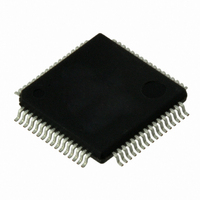VSC8601XKN Vitesse Semiconductor Corp, VSC8601XKN Datasheet - Page 30

VSC8601XKN
Manufacturer Part Number
VSC8601XKN
Description
IC PHY 10/100/1000 64-EP-LQFP
Manufacturer
Vitesse Semiconductor Corp
Type
PHY Transceiverr
Specifications of VSC8601XKN
Number Of Drivers/receivers
1/1
Protocol
Gigabit Ethernet
Voltage - Supply
2.5V, 3.3V
Mounting Type
Surface Mount
Package / Case
64-LQFP Exposed Pad, 64-eLQFP, 64-HLQFP
Case
TQFP
Dc
06+
Lead Free Status / RoHS Status
Lead free / RoHS Compliant
Other names
907-1028
Available stocks
Company
Part Number
Manufacturer
Quantity
Price
Company:
Part Number:
VSC8601XKN
Manufacturer:
KYOCERA/AVX
Quantity:
20 000
Company:
Part Number:
VSC8601XKN
Manufacturer:
VITESSE
Quantity:
1 235
Company:
Part Number:
VSC8601XKN
Manufacturer:
Vitesse Semiconductor Corporation
Quantity:
10 000
Part Number:
VSC8601XKN
Manufacturer:
VITESSE
Quantity:
20 000
3.12.3
3.13
3.13.1
Revision 4.1
September 2009
LED Behavior
Several LED behaviors can be programmed into the VSC8601 device. Use the settings
in register 17E to program LED behavior, which includes the following:
LED Combine Enables an LED to display status for a combination of primary and
secondary modes. This can be enabled or disabled for each LED pin. For example, a
copper link running in 1000BASE-T mode and activity present can be displayed with one
LED by configuring an LED pin to Link1000/Activity mode. The LED asserts when linked
to a 1000BASE-T partner and also blinks or pulse-stretches when activity is either
transmitted by the PHY or received by the link partner. The combine feature when
disabled only allows status of the primary function selected. In this example, only
Link1000 asserts the LED, and the secondary mode, activity, does not display if the
combine feature is disabled.
LED Blink or Pulse-Stretch This behavior is used for activity and collision indication.
This can be uniquely configured for each LED pin. Activity and collision events can occur
randomly and intermittently throughout the link-up period. For activity or collision to be
visually seen, these two modes are provided. Blink is a 50% duty cycle oscillation of
asserting and de-asserting an LED pin. Pulse-stretch guarantees that an LED is asserted
and de-asserted for a specific period of time when activity is either present or not
present. These rates can also be configured using a register setting.
Rate of LED Blink or Pulse-Stretch
length when blink/pulse-stretch is enabled on an LED pin. The blink rate, which
alternates between a high and low voltage level at a 50% duty cycle, can be set to
2.5 Hz, 5 Hz, 10 Hz, or 20 Hz. For pulse-stretch, this can be set to 50 ms, 100 ms,
200 ms, or 400 ms.
LED Pulsing Enable To provide additional power savings, the LEDs (when asserted)
can be pulsed at 5 kHz, 20% duty cycle.
Testing Features
The VSC8601 device includes several testing features designed to make it easier to
perform system-level debugging and in-system production testing. This section
describes the available features.
Ethernet Packet Generator (EPG)
The device EPG can be used at each of the 10/100/1000BASE-T speed settings to
isolate problems between the MAC and the VSC8601 device, or between a locally
connected PHY and its remote link partner. Enabling the EPG feature effectively disables
all MAC interface transmit pins and selects the EPG as the source for all data
transmitted onto the twisted pair interface.
Note The EPG is intended for use with laboratory or in-system testing equipment only.
Do not use the EPG testing feature when the VSC8601 device is connected to a live
network.
To enable the VSC8601 device EPG feature, set the device register bit 29E.15 to 1.
When the EPG is enabled, packet loss occurs during transmission of packets from the
MAC to the PHY. However, the PHY receive output pins to the MAC are still active when
This controls the LED blink rate or pulse-stretch
Functional Descriptions
VSC8601 Datasheet
Page 30















